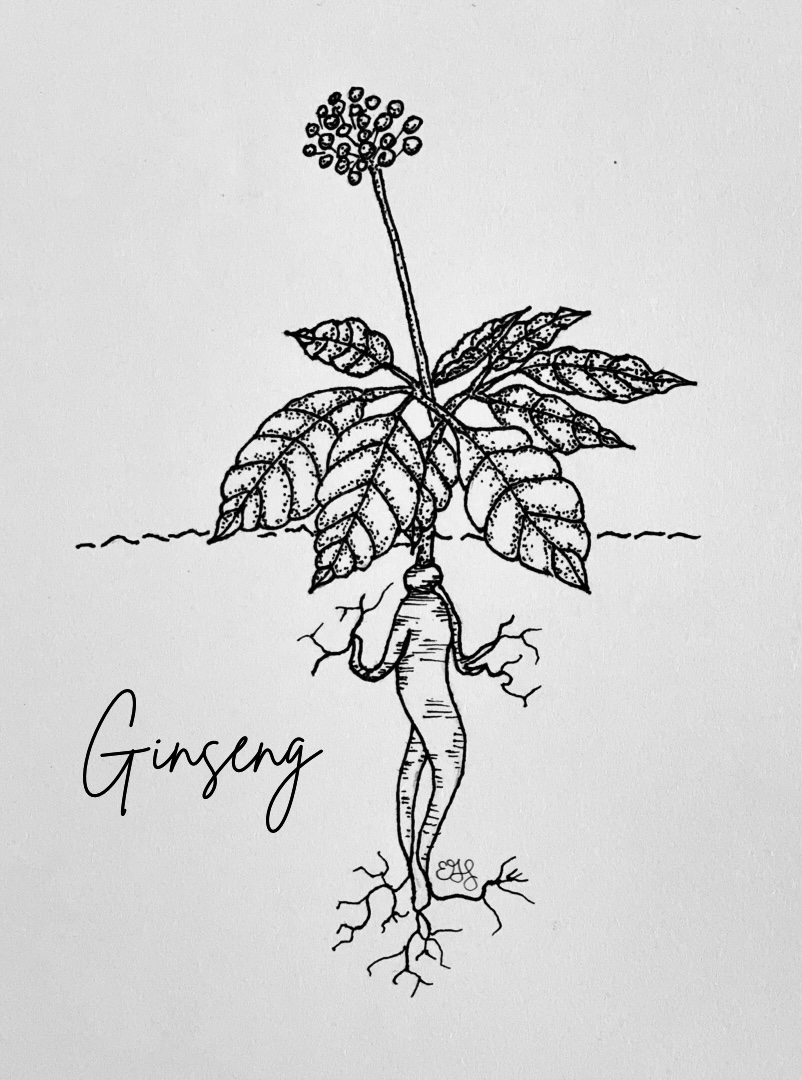Botanicals of the Month: March
Plant of the Month: Ginseng. Panax ginseng (Asian Ginseng) & Panax quinquefolius (American Ginseng)
doTerra Essential Oil of the Month: Petitgrain
Rishi Tea of the Month: Red Ginseng Iron Goddess Oolong
In keeping with the focus for the month of March, our botanical picks were chosen for the symbolism they provide; immortality and strength. The botanical picks for the month of March include the herb Ginseng, the essential oil Petitgrain and the tea Red Ginseng Iron Goddess Oolong. The plant is both American and Asian, and highly valued for their multitude of medicinal uses. Ginseng’s medicine is found in its root, a taproot that has to develop for at least 5-7 years before its ready for harvest. The word ginseng, in Chinese characters, actually translates to “human root,” and the plant is often referred to as “Man Root” because the forked shape of the roots resembles a human torso and legs. Some of the most prized specimens actually look like a whole human body, making ginseng one of those “Doctrine of Signatures,” plants, which states that herbs resembling various parts of the body can be used by herbalists to treat ailments of those body parts.
The botanical genus name, Panax, is derived from the Greek “Panakos” (meaning “all-cure,” or panacea) in reference to the variety of health benefits attributed to the herb. Native Americans have used American ginseng to treat fever, headaches, pain and indigestion. Traditional Chinese medicine has used Asian ginseng for 5000 years to treat anything from colds, respiratory disorders, impotency, and fatigue to cancer, as well as to promote stamina, strength, concentration, improved memory and slow the aging process.
Our tea of the month was selected because of ginseng’s role in bolstering the immune system during the change of seasons. Fittingly, it’s symbolic for immortality and strength. While it may not allow you to live forever, folks have been using it to live longer, better and stronger lives for a very long time.
With a flavor that’s said to be sweetly aromatic, wild ginseng can be processed into red or white ginseng. Both are available in liquid extracts, tinctures, tonics, teas, energy drinks, powders and capsules. The root can also be chewed raw, used in fresh tea, soups and stir fries. Or, it can also be dried. In Chinese medicine, Asian and American ginseng plants are actually used for different treatments. American ginseng is considered to nourish the yin energy, meaning it’s cooling and moistening. Asian ginseng, however, has the dry and warming qualities of “tonifying yang.”[i]
The essential oil, Petitgrain, also has historical roots, widely used in the perfume industry and is distilled from the bitter orange tree leaves and twigs. This essential oil can be diffused for a calming and relaxing aroma, help with feelings of tension by applying it topically and a drop or two added to water for help with the immune system.
American ginseng is an herbaceous perennial, found in the woodlands and native to eastern North America. Hardy in zones 3-8, it grows on the shaded floors of mature deciduous hardwood forests and is not an easy one to grow. For starters, the seeds take 18-21 months to germinate, requiring at least a full year of seasonal cold/warm cycles before it will sprout in its second spring. It then requires the forest floor’s moist, nutrient-rich soil and leaf litter to mature over the next 5+ years, before it can even be considered ready for harvest. Ginseng is considered a slow grower, and has been known to live up to and beyond 25 years. These plants have a history of being a hot commodity for hundreds of years. Harvested for trade, to this day, growers need to protect their crops due to pillaging.
In plant folklore, it’s said that Panax will bring beauty, love, money, sexuality, and health to all who carry it. After doing the research for this blog, I would like to weigh in on this. Money, yes, given the high demand for this plant, I can buy that. Health, absolutely, with thousands of years to back it up. Sexuality, yup, it’s a well-known aphrodisiac. Beauty, maybe, ginseng is used in some skin care products. The jury’s still out on love though. I haven’t run across any yet, but heaven only knows how many love stories have been born while on the quest for some ginseng.

